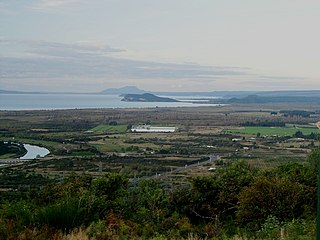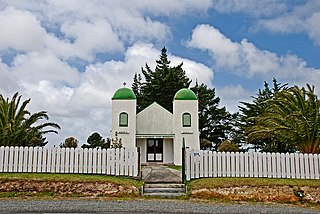Iwi are the largest social units in New Zealand Māori society. In Māori, iwi roughly means 'people' or 'nation', and is often translated as "tribe," or "a confederation of tribes." The word is both singular and plural in the Māori language, and is typically pluralised as such in English.

Ngāti Porou is a Māori iwi traditionally located in the East Cape and Gisborne regions of the North Island of New Zealand. Ngāti Porou is affiliated with the 28th Maori Battalion, it also has the second-largest affiliation of any iwi, behind Ngāpuhi with an estimated 92,349 people according to the 2018 census. The traditional rohe or tribal area of Ngāti Porou extends from Pōtikirua and Lottin Point in the north to Te Toka-a-Taiau in the south. The Ngāti Porou iwi also comprises 58 hapū (sub-tribes) and 48 mārae.

Ngāti Tūwharetoa is an iwi descended from Ngātoro-i-rangi, the priest who navigated the Arawa canoe to New Zealand. The Tūwharetoa region extends from Te Awa o te Atua at Matatā across the central plateau of the North Island to the lands around Mount Tongariro and Lake Taupō.
Arawa was one of the great ocean-going, voyaging canoes in Māori traditions that was used in the migrations that settled New Zealand.

Te Aupōuri is the second northernmost Māori iwi, located north of Kaitaia, Northland, New Zealand, a region known as the Te Hiku o te Ika. The iwi is one of the six Muriwhenua iwi of the far north of the North Island.

In Māori tradition, Ngātoro-i-rangi (Ngātoro) is the name of a tohunga (priest) prominent during the settling of New Zealand (Aotearoa) by the Māori people, who came from the traditional homeland Hawaiki on the Arawa canoe. He is the ancestor of Ngāti Tūwharetoa and his travels around Lake Taupō and up onto the Volcanic Plateau are the basis of Ngāti Tūwharetoa's claim to those regions.

In Māori tradition, Tainui was one of the great ocean-going canoes in which Polynesians migrated to New Zealand approximately 800 years ago. It was commanded by the chief Hoturoa, who had decided to leave Hawaiki because over-population had led to famine and warfare. The ship first reached New Zealand at Whangaparāoa in the Bay of Plenty and then skirted around the north coast of the North Island, finally landing at Kawhia in the western Waikato. The crew of the Tainui were the ancestors of the iwi that form the Tainui confederation.
Mātaatua was one of the great voyaging canoes by which Polynesians migrated to New Zealand, according to Māori tradition. Māori traditions say that the Mātaatua was initially sent from Hawaiki to bring supplies of kūmara to Māori settlements in New Zealand. The Mātaatua was captained by Toroa, accompanied by his brother, Puhi; his sister, Muriwai; his son, Ruaihona; and daughter, Wairaka.

Ngāti Rongomaiwahine or Rongomaiwahine is a Māori iwi (tribe) traditionally centred in the Māhia Peninsula on the North Island of New Zealand. In the 2006 census, 4,254 people identified as Rongomaiwahine; by the 2013 census, this has increased to 4,473 people. It is closely connected to the Ngāti Kahungunu iwi.
In Māori tradition, Māhuhu-ki-te-rangi was one of the great ocean-going, voyaging canoes that was used in the migrations that settled New Zealand.

Te Uri-o-Hau is a Māori iwi (tribe) based around New Zealand's Kaipara Harbour. It is both an independent iwi and a hapū (sub-tribe) of the larger Ngāti Whātua iwi, alongside Ngāti Whātua-o-Ōrākei, Te Roroa and Te Taoū. Its rohe includes Dargaville, Maungaturoto, Mangawhai, Kaiwaka and Wellsford.
In Māori tradition, Mānuka was one of the great ocean-going, voyaging canoes that was used in the migrations that settled the South Island of Aotearoa. The canoe is said to have travelled to the Polynesian homeland of Hawaiki to procure kūmara, a type of sweet potato. Although the Mānuka returned with kūmara, most accounts state that efforts to germinate and grow the tubers it brought back ended in failure.
In Māori tradition, Waipapa was one of the great ocean-going, voyaging canoes that was used in the migrations that settled Northland of Aotearoa. The captains were Kaiwhetu and Wairere, who landed the waka in Doubtless Bay.

Clifford Hamilton Whiting was a New Zealand artist, teacher and advocate for Māori heritage.

Robert Sullivan is a Māori poet, academic and editor. His published poetry collections include Jazz Waiata (1990), Star Waka (1999) and Shout Ha! to the Sky (2010). His books are postmodern, explore social and racial issues, and explore aspects of Māori culture and history.

Ngāti Whātua Ōrākei or Ngāti Whātua-o-Ōrākei is an Auckland-based Māori hapū (sub-tribe) in New Zealand. Together with Te Uri-o-Hau, Te Roroa and Te Taoū, it comprises the iwi (tribe) of Ngāti Whātua. These four hapū can act together or separately as independent tribes. The hapū's rohe is mostly in Tāmaki Makaurau, the site of present-day Auckland. Ngāti Whātua Ōrākei has around 6,000 members whose collective affairs are managed by the Ngāti Whātua Ōrākei Trust.

Tāmaki Māori are Māori iwi and hapū who have a strong connection to Tāmaki Makaurau, and whose rohe was traditionally within the region. Among Ngā Mana Whenua o Tāmaki Makaurau, also known as the Tāmaki Collective, there are thirteen iwi and hapū, organised into three rōpū (collectives), however Tāmaki Māori can also refer to subtribes and historical iwi not included in this list.
Toi-te-huatahi, also known as Toi and Toi-kai-rākau, is a legendary Māori tupuna (ancestor) of many Māori iwi (tribes) from the Bay of Plenty area, including Ngāti Awa, Ngāi Te Rangi and Ngāi Tūhoe. The Bay of Plenty's name in te reo Māori, Te Moana-a-Toi, references Toi-te-huatahi.

Portages in New Zealand, known in Māori as Tō or Tōanga Waka, are locations where waka (canoes) could easily be transported overland. Portages were extremely important for early Māori, especially along the narrow Tāmaki isthmus of modern-day Auckland, as they served as crucial transportation and trade links between the east and west coasts. Portages can be found across New Zealand, especially in the narrow Northland and Auckland regions, and the rivers of the Waikato Region.











